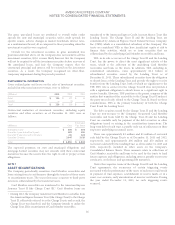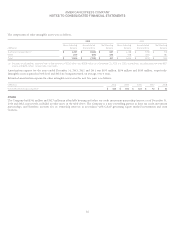American Express 2013 Annual Report Download - page 92
Download and view the complete annual report
Please find page 92 of the 2013 American Express annual report below. You can navigate through the pages in the report by either clicking on the pages listed below, or by using the keyword search tool below to find specific information within the annual report.
AMERICAN EXPRESS COMPANY
NOTES TO CONSOLIDATED FINANCIAL STATEMENTS
de-designated or terminated prior to maturity, the amount previously
recorded in AOCI is recognized into earnings over the period that the
hedged item impacts earnings. If a hedge relationship is discontinued
because it is probable that the forecasted transaction will not occur
according to the original strategy, any related amounts previously
recorded in AOCI are recognized into earnings immediately. No
ineffectiveness associated with cash flow hedges was reclassified from
AOCI into income for the years ended December 31, 2013, 2012 and
2011.
In the normal course of business, as the hedged cash flows are
recognized into earnings, the Company does not expect to reclassify
any amount of net pretax losses on derivatives from AOCI into
earnings during the next 12 months.
NET INVESTMENT HEDGES
A net investment hedge is used to hedge future changes in currency
exposure of a net investment in a foreign operation. The Company
primarily designates foreign currency derivatives, typically foreign
exchange forwards, and on occasion foreign currency denominated
debt, as hedges of net investments in certain foreign operations. These
instruments reduce exposure to changes in currency exchange rates on
the Company’s investments in non-U.S. subsidiaries. The effective
portion of the gain or (loss) on net investment hedges, net of taxes,
recorded in AOCI as part of the cumulative translation adjustment,
was $253 million, $(288) million and $(26) million for the years ended
2013, 2012 and 2011, respectively. Any ineffective portion of the gain
or (loss) on net investment hedges is recognized in other expenses
during the period of change. Ineffectiveness associated with net
investment hedges of nil, nil and $(3) million were recognized as a
component of other expenses for the years ended December 31, 2013,
2012 and 2011, respectively. No amounts associated with net
investment hedges were reclassified from AOCI to income during the
years ended December 31, 2013, 2012 and 2011.
DERIVATIVES NOT DESIGNATED AS HEDGES
The Company has derivatives that act as economic hedges, but are not
designated as such for hedge accounting purposes. Foreign currency
transactions and non-U.S. dollar cash flow exposures from time to
time may be partially or fully economically hedged through foreign
currency contracts, primarily foreign exchange forwards, options and
cross-currency swaps. These hedges generally mature within one year.
Foreign currency contracts involve the purchase and sale of a
designated currency at an agreed upon rate for settlement on a
specified date. The changes in the fair value of the derivatives
effectively offset the related foreign exchange gains or losses on the
underlying balance sheet exposures. From time to time, the Company
may enter into interest rate swaps to specifically manage funding costs
related to its proprietary card business.
The Company has certain operating agreements containing
payments that may be linked to a market rate or price, primarily
foreign currency rates. The payment components of these agreements
may meet the definition of an embedded derivative, in which case the
embedded derivative is accounted for separately and is classified as a
foreign exchange contract based on its primary risk exposure.
For derivatives that are not designated as hedges, changes in fair
value are reported in current period earnings.
The following table summarizes the impact on pretax earnings of derivatives not designated as hedges, as reported on the Consolidated
Statements of Income for the years ended December 31:
Pretax gains (losses)
Amount
Description (Millions) Income Statement Line Item 2013 2012 2011
Interest rate contracts Other expenses $1$ (1) $ 3
Foreign exchange contracts(a) Interest and dividends on investment securities ——9
Interest expense on short-term borrowings ——3
Interest expense on long-term debt and other —(1) 130
Other expenses 72 (56) 51
Total $ 73 $ (58) $ 196
(a) Foreign exchange contracts include embedded foreign currency derivatives. Gains (losses) on these embedded derivatives are included in other expenses.
90
























